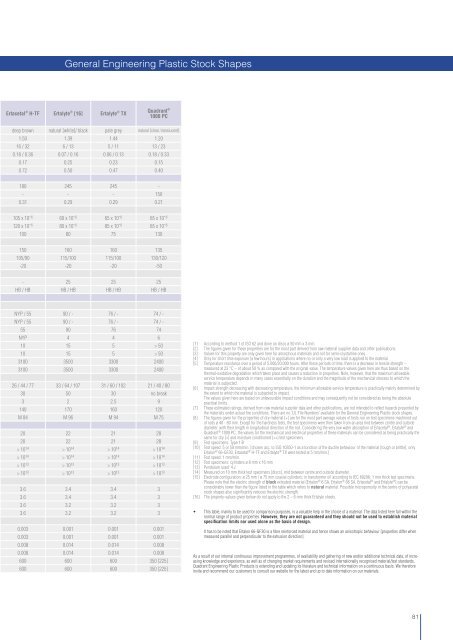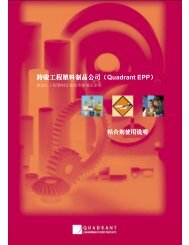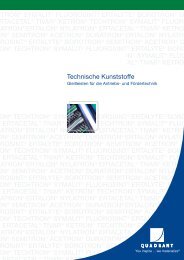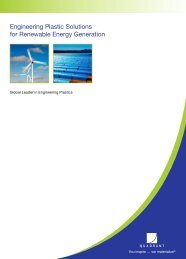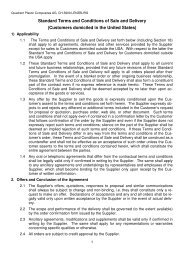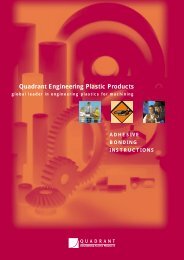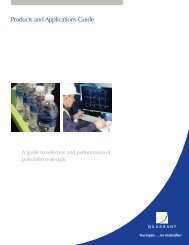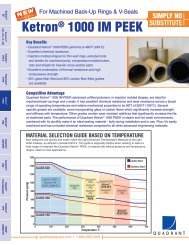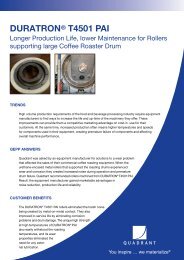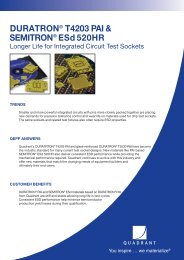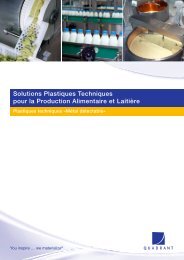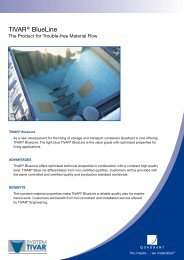Product Guide for Design Engineers - Quadrant
Product Guide for Design Engineers - Quadrant
Product Guide for Design Engineers - Quadrant
You also want an ePaper? Increase the reach of your titles
YUMPU automatically turns print PDFs into web optimized ePapers that Google loves.
General Engineering Plastic Stock Shapes<br />
Ertacetal ® H-TF Ertalyte ® [16] Ertalyte ® TX<br />
<strong>Quadrant</strong> ®<br />
1000 PC<br />
deep brown natural [white]/ black pale grey natural [clear, translucent]<br />
1.50 1.39 1.44 1.20<br />
16 / 32 6 / 13 5 / 11 13 / 23<br />
0.18 / 0.36 0.07 / 0.16 0.06 / 0.13 0.18 / 0.33<br />
0.17 0.25 0.23 0.15<br />
0.72 0.50 0.47 0.40<br />
180 245 245 -<br />
- - - 150<br />
0.31 0.29 0.29 0.21<br />
105 x 10 -6 60 x 10 -6 65 x 10 -6 65 x 10 -6<br />
120 x 10 -6 80 x 10 -6 85 x 10 -6 65 x 10 -6<br />
100 80 75 130<br />
150 160 160 135<br />
105/90 115/100 115/100 130/120<br />
-20 -20 -20 -50<br />
- 25 25 25<br />
HB / HB HB / HB HB / HB HB / HB<br />
NYP / 55 90 / - 76 / - 74 / -<br />
NYP / 55 90 / - 76 / - 74 / -<br />
55 90 76 74<br />
NYP 4 4 6<br />
10 15 5 > 50<br />
10 15 5 > 50<br />
3100 3500 3300 2400<br />
3100 3500 3300 2400<br />
26 / 44 / 77 33 / 64 / 107 31 / 60 / 102 21 / 40 / 80<br />
30 50 30 no break<br />
3 2 2.5 9<br />
140 170 160 120<br />
M 84 M 96 M 94 M 75<br />
20 22 21 28<br />
20 22 21 28<br />
> 10 14 > 10 14 > 10 14 > 10 14<br />
> 10 14 > 10 14 > 10 14 > 10 14<br />
> 10 13 > 10 13 > 10 13 > 10 13<br />
> 10 13 > 10 13 > 10 13 > 10 13<br />
3.6 3.4 3.4 3<br />
3.6 3.4 3.4 3<br />
3.6 3.2 3.2 3<br />
3.6 3.2 3.2 3<br />
0.003 0.001 0.001 0.001<br />
0.003 0.001 0.001 0.001<br />
0.008 0.014 0.014 0.008<br />
0.008 0.014 0.014 0.008<br />
600 600 600 350 [225]<br />
600 600 600 350 [225]<br />
[1] According to method 1 of ISO 62 and done on discs ø 50 mm x 3 mm.<br />
[2] The fi gures given <strong>for</strong> these properties are <strong>for</strong> the most part derived from raw material supplier data and other publications.<br />
[3] Values <strong>for</strong> this property are only given here <strong>for</strong> amorphous materials and not <strong>for</strong> semi-crystalline ones.<br />
[4] Only <strong>for</strong> short time exposure [a few hours] in applications where no or only a very low load is applied to the material.<br />
[5] Temperature resistance over a period of 5.000/20.000 hours. After these periods of time, there is a decrease in tensile strength –<br />
measured at 23 °C – of about 50 % as compared with the original value. The temperature values given here are thus based on the<br />
thermal-oxidative degradation which takes place and causes a reduction in properties. Note, however, that the maximum allowable<br />
service temperature depends in many cases essentially on the duration and the magnitude of the mechanical stresses to which the<br />
material is subjected.<br />
[6] Impact strength decreasing with decreasing temperature, the minimum allowable service temperature is practically mainly determined by<br />
the extent to which the material is subjected to impact.<br />
The values given here are based on unfavourable impact conditions and may consequently not be considered as being the absolute<br />
practical limits.<br />
[7] These estimated ratings, derived from raw material supplier data and other publications, are not intended to reflect hazards presented by<br />
the materials under actual fi re conditions. There are no ‘UL File Numbers’ available <strong>for</strong> the General Engineering Plastic stock shapes.<br />
[8] The fi gures given <strong>for</strong> the properties of dry material [+] are <strong>for</strong> the most part average values of tests run on test specimens machined out<br />
of rods ø 40 - 60 mm. Except <strong>for</strong> the hardness tests, the test specimens were then taken from an area mid between centre and outside<br />
diameter, with their length in longitudinal direction of the rod. Considering the very low water absorption of Ertacetal ® , Ertalyte ® and<br />
<strong>Quadrant</strong> ® 1000 PC, the values <strong>for</strong> the mechanical and electrical properties of these materials can be considered as being practically the<br />
same <strong>for</strong> dry [+] and moisture conditioned [++] test specimens.<br />
[9] Test specimens: Type 1 B<br />
[10] Test speed: 5 or 50 mm/min. [chosen acc. to ISO 10350-1 as a function of the ductile behaviour of the material [tough or brittle]; only<br />
Ertalon ® 66-GF30, Ertacetal ® H-TF and Ertalyte ® TX were tested at 5 mm/min.]<br />
[11] Test speed: 1 mm/min.<br />
[12] Test specimens: cylinders ø 8 mm x 16 mm<br />
[13] Pendulum used: 4 J<br />
[14] Measured on 10 mm thick test specimens [discs], mid between centre and outside diameter.<br />
[15] Electrode configuration: ø 25 mm / ø 75 mm coaxial cylinders; in trans<strong>for</strong>mer oil according to IEC 60296; 1 mm thick test specimens.<br />
Please note that the electric strength of black extruded material [Ertalon ® 6 SA, Ertalon ® 66 SA, Ertacetal ® and Ertalyte ® ] can be<br />
considerably lower than the fi gure listed in the table which refers to natural material. Possible microporosity in the centre of polyacetal<br />
stock shapes also signifi cantly reduces the electric strength.<br />
[16] The property-values given below do not apply to the 2 – 6 mm thick Ertalyte sheets.<br />
• This table, mainly to be used <strong>for</strong> comparison purposes, is a valuable help in the choice of a material. The data listed here fall within the<br />
normal range of product properties. However, they are not guaranteed and they should not be used to establish material<br />
specifi cation limits nor used alone as the basis of design.<br />
It has to be noted that Ertalon 66-GF30 is a fi bre rein<strong>for</strong>ced material and hence shows an anisotropic behaviour [properties differ when<br />
measured parallel and perpendicular to the extrusion direction].<br />
As a result of our internal continuous improvement programmes, of availability and gathering of new and/or additional technical data, of increasing<br />
knowledge and experience, as well as of changing market requirements and revised internationally recognised material/test standards,<br />
<strong>Quadrant</strong> Engineering Plastic <strong>Product</strong>s is extending and updating its literature and technical in<strong>for</strong>mation on a continuous basis. We there<strong>for</strong>e<br />
invite and recommend our customers to consult our website <strong>for</strong> the latest and up to date in<strong>for</strong>mation on our materials.<br />
81


